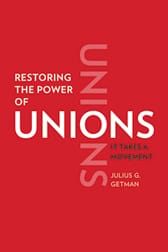Health Insurance for 20 Million is at Risk
If Congress fails to renew the ACA enhanced benefits, millions will be unable to access the health care they need.
A review of Restoring the Power of Unions: It Takes A Movement by Julius Getman (New Haven, Yale University Press, 2010).

The remaking of the Hotel and Restaurant Employees (HERE) union over the past 40 years began in New Haven, Conn., where current UNITE HERE president John Wilhelm, a product of Sixties’ student activism, was fortunate to have both an unusual mentor and a faithful Boswell. In 1969, two years after graduating from Yale, Wilhelm was doing SDS-influenced community organizing in New Haven. While taking a break from his paid job as a laundry delivery driver, he noticed “a weird ad” in the newspaper. It read: “Labor leader trainee wanted, long hours, low pay, must be single.” Sorting through the few replies, including Wilhelm’s, was Vincent Sirabella, a charismatic union militant with a 9th-grade education and a passion for organizing the unorganized. Sirabella chose Wilhelm to be his apprentice HERE business agent (even though he was already married). Before accepting, Wilhelm consulted his “Movement” colleagues; they warned him that unions were “racist, misogynist, imperialist, and hopeless.”
Fortunately, Wilhelm took the job anyway. Under Sirabella’s tutelage, he helped blue-collar workers at Yale battle the university throughout the 1970s, and then built a second campus local composed of 2,500 clerical and technical employees. Within several decades, Wilhelm succeeded his mentor as HERE national organizing director; he then became its secretary treasurer, and later, its president. In 2004, HERE merged with the garment workers union, known as UNITE. Claiming 440,000 members, UNITE HERE became one of the founders of the seven-union coalition that broke away from the AFL-CIO to form Change To Win.
Julius Getman, a former NLRB attorney and arbitrator, joined the law faculty at Yale in 1977, when Sirabella and Wilhelm were both still active locally. He began studying the innovative approaches to organizing and contract bargaining they employed, first in New Haven and then throughout the country. Getman’s new book, Restoring the Power Of Unions, is a comprehensive study of a once-troubled union that has made an impressive comeback by waging difficult workplace and community-based campaigns. The book explains a lot about why UNITE HERE—though one tenth the size of its one-time ally, the Service Employees International Union (SEIU)—has fared so well in the struggle between the two, which began when SEIU intervened in one of the messiest union divorces in recent history.
As Getman recounts, the six-year marriage of Bruce Raynor’s UNITE and Wilhelm’s HERE broke up in early 2009. Facing re-election defeat as president of the merged union, Raynor led a minority faction of UNITE HERE into SEIU. After they split, SEIU and UNITE HERE engaged in bitter workplace fights over who should represent existing members and a federal court battle over the nation’s largest labor-owned bank. While that costly litigation was finally settled in July and a workplace truce declared, Wilhelm led his members out of Change to Win, in protest over SEIU’s behavior, and back into the AFL-CIO. He also aided the National Union of Healthcare Workers (NUHW), the independent union that is trying to oust SEIU at Kaiser Permanente and other hospital chains in California. (See “SEIU Civil War Puts Labor-Management �Partnership’ in a New Light,” Dollars & Sense, September/October, 2009.)
One key to HERE’s considerable success, both in recent inter-union competition and ongoing clashes with major employers, is its emphasis on one-on-one recruitment of rank-and-file activists and building strong workplace committees. As Getman argues, HERE functions like a real “workers movement,” “activating and using the energies of workers” rather than merely deploying savvy young researchers, PR specialists, and corporate campaigners. He describes how HERE has overcome a daunting series of internal and external obstacles “through a remarkable collaboration between up-from-the-ranks working-class leadership and progressive, college-trained political activists with roots in the student and civil rights movement.” Some internal critics would say that the “college-trained” have disproportionate clout and the union’s organizing model is overly cultish. These are downsides of HERE that the author does not spend much time exploring. Nevertheless, anyone interested in organizational change in labor will find Getman’s book to be the best study available of the progress that’s been made, and the challenges that still confront those working to restore union power in the hotel industry.